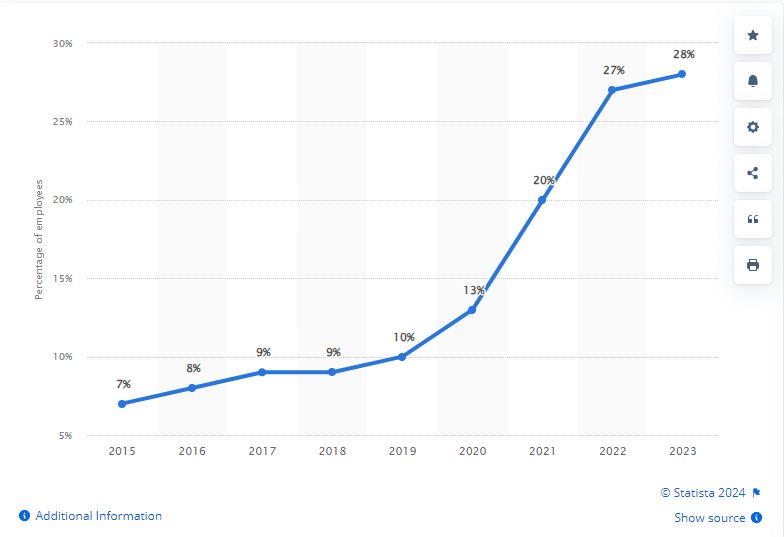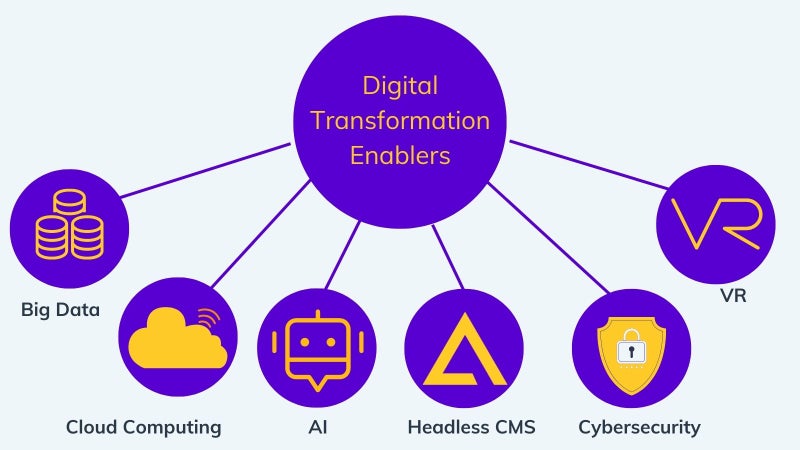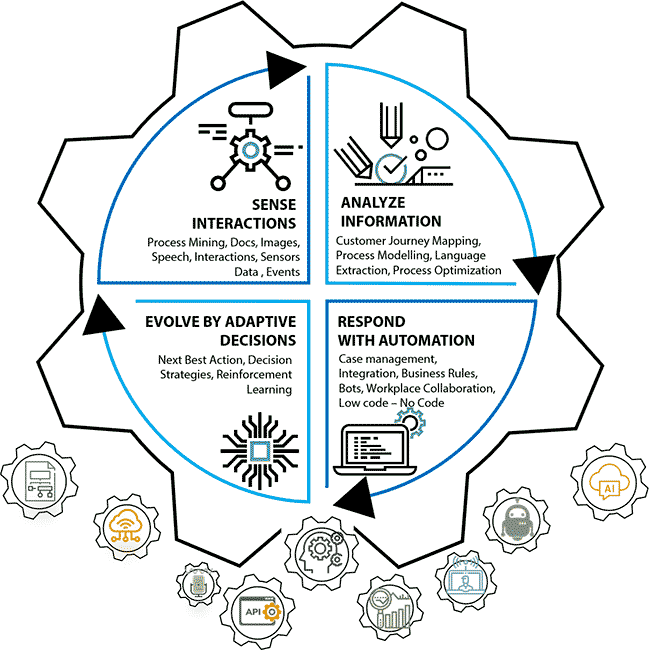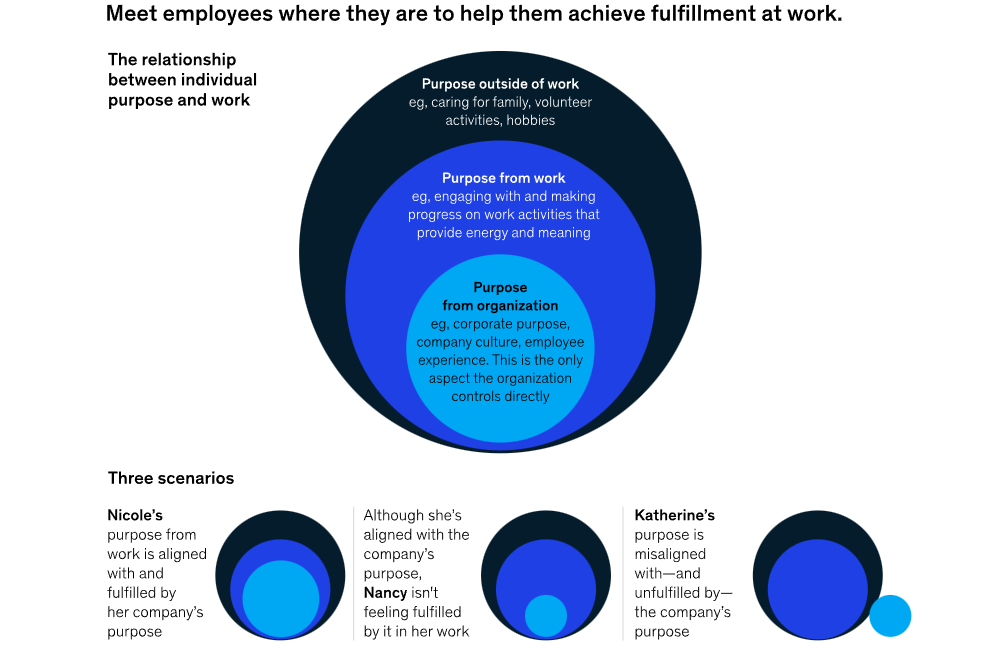Since a global pandemic turned the world upside down, digital transformation has introduced so much new technology into the workplace that organizations are constantly striving to create a seamless digital working environment.
A digital work environment demands have resulted in more employee productivity and a better work life balance - and in most cases - new digital workplace tools have really improved employee experience.
In this guide, we'll explore the natural evolution of the digital workplace, what's expected in the immediate future of the digital workplace model, and the workplace technologies that make it happen.
We'll focus on the digital employee experience, and how employee satisfaction is a key driver to ensuring a successful and secure digital workplace.
Read our guide to future-proofing the hybrid workplace
How a digital workplace enables team members to thrive
Every digital workplace strategy requires a shift in the way things are done in the workplace. Over the last decade, working culture has gradually changed from being desk-based with fixed devices, to one of almost unlimited mobility thanks to the influx of new technology.
Workplace culture is now firmly and unequivocally dependent on an organization's efforts to enable employees to comfortably embrace digital transformation. After all, the success of a business is reliant on its workers, and therefore employee satisfaction accelerates business opportunities, enables cost savings, and creates a much more competitive edge.
Today's digital workplaces are always-connected environments, enabling instant access to all the digital tools an employee would want to facilitate communication - from whatever location they choose, whenever they choose.
In an effort to ensure a seamless digital workplace experience, employers have adopted universal strategies including:
- Providing asynchronous and synchronous communication tools
- Measures to encourage employee feedback by implementing employee surveys
- Facilitating flexible work schedules that enable a better work life balance
- Machine learning and robotic process automation in customer services
- Extensive initial training, plus ongoing learning opportunities to increase digital literacy
- Monitoring and tracking the user satisfaction that digital models deliver
The rise of the digital workplace
While 'non-desk workers' (like factory workers, warehouse workers and outside sales reps) may make up the majority of the workforce, knowledge workers are the primary consumers in a digital workplace.
Before the pandemic, only 8% of remote-capable employees (meaning their job can be done remotely at least part of the time), worked exclusively from home, while about one-third had a hybrid work arrangement.
More recently, the share of employees working remotely increasing to some 27 percent in 2022 from just 13 percent two years prior. The industry with the highest share of remote workers globally in 2023 was by far the technology sector, with over 67 percent of tech employees worldwide working fully or mostly remotely.

The pandemic forced the vast majority of employees to adopt a remote work model in some capacity, and as many as 70% worked exclusively from home in May of 2020.
As it stands, approximately half of the U.S. full-time workforce, or about 60 million workers report that their current job can be done remotely working from home, at least part of the time.
Technology as the enabler
The rapid adoption of hybrid working has created an unprecedented growth in technological capabilities. An exponential increase in computing power available to both consumers and enterprises, as well as vast improvements in internet connection is changing the way employees and companies work.

Image source: Agility CMS
Additionally, the evolution of cloud technology has enabled the rapid development of digital communication platforms, almost limitless storage of digital records, data mining, and better security, making virtual and global collaboration possible in more fields every day.
Artificial Intelligence (AI) and Virtual Reality (VR) are facilitating learning, research and business growth and helping to better distribute business resources and employee strengths where they are most needed.
Technology, including virtual meeting tools and applications, has facilitated the end of the permanent 9 to 5 commute, and made digital workplaces location-agnostic.
Employees are no longer committed to a desktop PC and a static desk in a physical office. They can use almost any device imaginable to communicate and collaborate from any platform at any time, from different cities or anywhere in the world.
Gartner says, “The Digital Workplace enables new, more effective ways of working; raises employee engagement and agility, and exploits consumer-oriented styles and technologies.”
Developing a digital working framework
Globally, organizations have adopted strategies for inclusive digital workplaces that includes better employee motivation, state-of-the-art collaboration tools and business applications. Digital workplace tools, platforms and initiatives influence how technology is transforming the type of work employees perform, as well as where and how work gets done.
By implementing digital workplace frameworks, companies can effectively break down the barriers dividing effective communication and collaboration.
Whether an organization wants to focus on cost savings, improving collaboration, or enhancing customer experiences, it's imperative to clearly define goals, track progress through key performance indicators (KPIs), encourage feedback, and make changes accordingly. This can help businesses have a better understanding of what success looks like after a digital workplace rollout.
Full digital transformation doesn't happen overnight. A successful digital workplace infrastructure is the one that can align the right technology and the right talent with an organization’s future goals.

Image source: Jisc
Here are some of the digital workplace components that are key to a successful digital ecosystem:
Synchronous and asynchronous communication channels
A digital workplace platform should allow employees to communicate synchronously with each other (or in real time), regardless of their location, or the device they might be using.
It can enable knowledge sharing when teams aren’t present in the same physical office space and can’t have face to face meetings every day. Asynchronous communication is also important because it allows employees to respond to messages in their own time, as well as giving remote team members the opportunity to create their own work schedule.

Project management
The digital workplace can allow for better project management by establishing policies, procedures, and principles for successfully taking a project from conception to completion phase. It ensures all the involved departments in the organization are able to work together efficiently in order to achieve the project goals.
Teams can create new projects directly inside the digital workplace platform and collaborate in real-time. Project management will also enable employees to manage and track projects to ensure all the deadlines are met and project information is available easily for everyone involved.

Image source: Clear People
Process management
Process management helps organizations create, edit, and analyze internal processes that make up the very core of their business by helping assess the current state of the organization and identifying areas of improvement.
With a digital workplace, organizations can digitize and convert their internal business processes into streamlined workflows.
Digital workplaces can identify and automate the repetitive, routine and predictable parts of a process with machine learning technology, which can save employees time and allow them to focus on more important responsibilities.

Image source: Infosys
Case management
Case management is the method of processing information through a combination of digitized workflows and human decision making. It offers a dynamic structure to execute unpredictable and non-routine business processes that require complex decision making.
Cases can be different, depending on the organization. For example, a case could be meeting a service request, or resolving a customer complaint.
A great digital workplace experience makes it easier to handle cases from multiple users through a single interface. It also facilitates effective collaboration and expedites priority cases within the organization to ensure speedy resolution.
Analytics
An important aspect of a successful digital workplace strategy is the implementation of detailed and intelligent analytics tools. These tools help turn vast amounts of the dissonant data generated in a digital workplace into actionable insights.
With clear and cohesive analytics with the digital workplace, organizations can easily translate company data into charts, infographics and simplified forms to provide enhanced insight. Additionally, a digital workplace with powerful analytics tools can have a bird’s-eye view of everything needed to make important decisions.
Great analytics tools also pave the way to higher productivity as they automate data analysis and deliver powerful insights with minimal human effort.

For more comprehensive insights, Read our guide 'How to Create a Digital Workplace Strategy'
Digital workplace monitoring
One of the most important digital workplace solutions is third party (vendor agnostic) performance management software that allows you to take a precise look at your entire UC environment.
In a digital workplace, there are usually several different technologies that have to function together in order to achieve optimum performance. A distributed workforce consists mainly of employees operating between a physical office and a remote location, using multiple mobile devices and different communication apps.
This means there are bound to be technical problems that can affect user productivity as well as employee experience and satisfaction:
- Slow login, or an inability to login at all
- Video calls dropping out
- Screens freezing
- Glitchy audio
- Meetings disconnecting
- Breaches in data security
- Inability to transfer or access files
- Device incompatibility
The cost of downtime
-
Monitoring this complex environment in real time is mission-critical for organizations, and a key part of a digital workplace strategy - or they risk serious downtime.
-
Forbes reports that the financial cost of downtime has recently soared. For large businesses, downtime now costs an average of $9,000 per minute, but in industries like finance or healthcare, downtime expenses can reach up to $5 million per hour.
-
And this doesn't include any fines or penalties that might apply if service agreements are breached.
How digital workplaces enable better employee engagement
The success of digital workplaces depends exclusively on the types of hybrid experiences employers create for their teams, and how managers adapt to and address employee expectations.
Gallup defines employee engagement as the involvement and enthusiasm of employees in their digital workplaces, and the enjoyment of the work they do there.
Employee engagement helps organizations to measure and manage employees' perspectives on the crucial elements of workplace culture, and their current digital workplace footprint.
You can find out if your employees are actively engaged with their work or simply showing up to do their hours. You can discover if your team building activities and human resources practices influence positive business outcomes, or if there's room for evaluation and improvement.
For every organization to be successful, a good employee experience is crucial. Among other things, it ensures a better quality of work within digital workplaces, more invested and dedicated employees with a greater commitment to the company. In fact, a study shows that organizations with engaged employees had up to 59% lower staff turnover.
Key drivers of better engaged employees
In digital workplaces, effective communication is essential to keeping employees engaged, inspired and motivated. Regularly checking in with them, and opening as many lines of communication as possible through invitational surveys will ensure that everyone feels included, appreciated and valued.

Image source: McKinsey
Elevating employee experience
The digital workplace has changed the way employees and management interact. There are distinct differences between today's digital workplace systems (a horizontal business) and management systems used in the past (a vertical business).
In a vertical system, upper-level management issues orders and employees follow those orders without input or objection.
In contrast, employees in a horizontal system are encouraged to make suggestions and offer input and ideas that can improve workplaces processes. An employer who values work life balance for their employees will undoubtedly have a happier workforce.
Enforcing a sense of purpose
In digital workplaces, a sense of purpose is often considered the biggest driver of engagement. When employees fully understand how their role within an organization contributes to its larger mission and impact, they feel a stronger connection, motivation, and enthusiasm for their work, resulting in increased engagement and commitment.
People want to feel inspired, derive purpose and meaning from their work, and to be recognized for what makes them unique. This is what drives employees to become, and remain engaged.
Developing employee relationships, particularly with a manager who can make employees feel more valuable by coaching them to the next level, is important.
According to studies by Gallup, the manager or team leader alone accounts for 70% of the variance in team engagement.
How the right equipment enhances employee engagement
In digital workplaces, employees use a number of digital workplace platforms and tools to get work done - from instant messaging applications to video communication tools, enterprise social media tools, knowledge sharing, automated workflows etc.
To get measurable results from a truly integrated digital workplace, all digital workplace platforms and every digital workplace solution should empower employees with feature-rich, intuitive collaboration tools for both internal communication and external.
Digital technology provides workers with an unlimited array of internet enabled devices that enable them to message, meet, voice and video call, share content, and communicate from any space.
Many employees prefer a Bring-Your-Own-Device (BYOD) policy, where they can use their own devices from mobile phones to laptops and tablets in their work environment.
It's extremely important, however, for managers to engage business and IT team leaders throughout the organization to agree on a common goal and clear vision for the way corporate communications should be adopted.
Why a physical workplace is still important
Digital workplaces can be defined as those that predominantly operate from anywhere, using digital tools. but having a physical location to come together is still vital to maintain workplace culture. Why is physical space as well as a digital workplace important?
Offices give an organization an identity
Although a business may be well known for its services, products, and the people behind it, a physical location also plays an important part in its identity and its existence in the marketplace.
But the hybrid working model has changed the purpose of the bricks-and-mortar office. It is no longer necessarily a place where people go for everyday work, to complete tasks autonomously - instead it has become a place where teams come together as part of a number of digital workplaces to collaborate.
Social interaction
Even in the digital workplace, there is still a need for physical interaction with others.
A common gathering venue or office space can be important to maintain a social work culture so that the employees and employers of the company can reinforce their roles, achievements, challenges and ideas smoothly as a team.
A sense of isolation is one of the challenges of remote working that for many employees can result in a poor experience. Socialization and teamwork are both interconnected and necessary as it empowers employees, and creates a great employee experience.
The benefits and challenges of the digital workplace
Digital workplaces drive productivity and collaboration by using advanced digital tools and technology to empower and engage teams.
Benefits of adopting a digital workplace include:
-
* Easier global work collaboration from one or several locations thanks to the availability of a variety of collaboration platforms
-
* Remote working can not only improve productivity, but it also enables flexibility for employees and employers. This leads to improved employee retention, improved productivity and greater workplace satisfaction and employee experience for the whole workforce
-
* Huge cost savings by diminishing the need for physical travel, expensive real estate and other conventional operating expenses
-
* Improved business connectivity, flexibility and agility with more opportunity for achieving business goals faster
-
* Directing more workflow into the digital space will deliver more insight into day-to-day operations, and improve transparency, helping identify successes and opportunities for improvement.
-
* Digital workplaces allow a company to acquire top talent, as they aren't bound by geographic or location constraints.
Read our blog post on
'How Hybrid Working can Improve your Talent Pool'
Challenges of digital transformation
While the benefits of digital solutions are many, the increasingly complex technologies required to create the digital workplace can lead to challenges for companies:
1. Employee resistance
-
Employees a may be resistant to having to learn anything new if they do not believe the change would make their work life easier. To overcome resistance and successfully introduce a digital workplace in your organization, it is important to explain the value it can provide employees to improve their work efficiency
2. Digital tools
-
The sheer variety and complexity of some digital tools and platforms for users to complete their tasks efficiently can be overwhelming. The way to overcome this is to create contextual, role-based onboarding flows, task lists, and other in-app guidance resources to help users learn about the different features and actions that are most important to them.
3. Cyber and information security
With continuous phishing scams and customer and employee data breaches worldwide, cyber security and information security have become the most significant challenges of a digital workplace. End-user security awareness programs and training can help employees understand the importance of data security and best practices to follow while accessing confidential data from their devices.
4. Issues with employee productivity
Employee productivity might fluctuate for the first few weeks after implementing new digital workplace practices. It can take time for your employees to get used to the new work environment.
Post-implementation, productivity depends on the effectiveness of training and and upskilling programs provided to employees to leverage the new platform.
5. Technology interoperability issues
-
Many various disparate software packages, communication technologies and other platforms are not designed to work together.
-
This can cause connectivity problems, interrupt online workflows, and hinder productivity. It can also lead to user frustration and reduce employee satisfaction. Monitoring and performance management solutions can help to identify and solve incompatibility issues quickly before it leads to downtime.
6. Isolation and lack of inclusion
-
Another problem within digital workplaces is disengaged remote workers, who feel disconnected from their workplace. Solutions include companies encouraging increased communication with their employees and engaging their attention, as well assisting them in prioritizing their time and resources.
7. Silos
-
Silos are a digital workplace problem and a company-wide communication problem, exacerbated by digital workplace challenges, causing a lack of alignment between teams and the rest of the organization. To shift the way businesses operate from employee pain-point to agile endpoint, companies will need to create an experience that meets the needs of every worker.
Data and analytics
In the digital workplace, big data and analytics are crucial to understanding end-user performance and which user-communities are impacted. Being able to see every level of your hybrid working ecosystem provides layers of intelligence and insights that create team cohesion, cost management, innovation, and growth.
With the disparate nature of hybrid working, digital workplaces could consist of dozens or even hundreds of different applications, devices, networks and locations. Monitoring all of these components in real time is mission-critical
Monitoring and performance management with IR Collabrate
It’s vital to monitor performance in real-time, and have the means to respond to problems immediately.
Third-party monitoring tools also allow you to view metrics, collect essential data and focus on insights and analytics that can make the difference between success or failure in the hybrid workplace.
The IR Collaborate suite of performance management solutions can give you the insights you need to monitor, troubleshoot and manage your entire hybrid workplace UC infrastructure from a single pane of glass.

Conclusion
The future of work is digital, and while digital technologies have enabled many benefits, the digital workplace comes with some fundamental flaws too. Technical issues, social and cultural issues, security challenges and unclear performance metrics.
But the benefits are clear. Digital workplaces deliver more agility, increased revenue, lower staff turnover, and this enhances business opportunities. When combined with the other cost savings provided by a digital workplace, encourages business growth.
By focusing on your employees, you can create a successful, productive and happy digital workplace.
To learn more about what the evolved digital workplace looks like, download our eBook:
Your Ultimate Guide to Future-proofing the Hybrid Workplace 2.0




